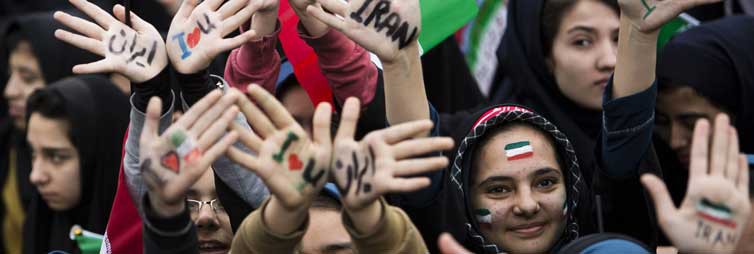noun: Iranian(s)
adjective: Iranian
Ethnic groups:
Persian, Azeri, Kurd, Lur, Baloch, Arab, Turkmen and Turkic tribes
Languages:
Persian (official), Azeri Turkic and Turkic dialects, Kurdish, Gilaki and Mazandarani, Luri, Balochi, Arabic, other
Religions:
Muslim (official) 99.4% (Shia 90-95%, Sunni 5-10%), other (includes Zoroastrian, Jewish, and Christian) 0.3%, unspecified 0.4% (2011 est.)
religious affiliation:
Population:
81,824,270 (July 2015 est.)
country comparison to the world: 17
Age structure:
0-14 years: 23.69% (male 9,937,715/female 9,449,716)
15-24 years: 17.58% (male 7,386,826/female 6,998,188)
25-54 years: 46.87% (male 19,534,794/female 18,817,480)
55-64 years: 6.58% (male 2,650,049/female 2,731,997)
65 years and over: 5.28% (male 1,990,961/female 2,326,544) (2015 est.)
population pyramid:
Dependency ratios:
total dependency ratio: 40.2%
youth dependency ratio: 33.1%
elderly dependency ratio: 7.1%
potential support ratio: 14.1% (2015 est.)
Median age:
total: 28.8 years
male: 28.6 years
female: 29.1 years (2015 est.)
Population growth rate:
1.2% (2015 est.)
country comparison to the world: 101
Birth rate:
17.99 births/1,000 population (2015 est.)
country comparison to the world: 105
Death rate:
5.94 deaths/1,000 population (2015 est.)
country comparison to the world: 168
Net migration rate:
-0.07 migrant(s)/1,000 population (2015 est.)
country comparison to the world: 114
Urbanization:
urban population: 73.4% of total population (2015)
rate of urbanization: 2.07% annual rate of change (2010-15 est.)
Major urban areas – population:
TEHRAN (capital) 8.432 million; Mashhad 3.014 million; Esfahan 1.88 million; Karaj 1.807 million; Shiraz 1.661 million; Tabriz 1.572 million (2015)
Sex ratio:
at birth: 1.05 male(s)/female
0-14 years: 1.05 male(s)/female
15-24 years: 1.06 male(s)/female
25-54 years: 1.04 male(s)/female
55-64 years: 0.97 male(s)/female
65 years and over: 0.86 male(s)/female
total population: 1.03 male(s)/female (2015 est.)
Maternal mortality rate:
25 deaths/100,000 live births (2015 est.)
country comparison to the world: 137
Infant mortality rate:
total: 38.04 deaths/1,000 live births
male: 38.58 deaths/1,000 live births
female: 37.48 deaths/1,000 live births (2015 est.)
country comparison to the world: 54
total population: 71.15 years
male: 69.56 years
female: 72.82 years (2015 est.)
country comparison to the world: 149
Total fertility rate:
1.83 children born/woman (2015 est.)
country comparison to the world: 148
Contraceptive prevalence rate:
77.4% (2010/11)
Health expenditures:
6.7% of GDP (2013)
country comparison to the world: 86
Physicians density:
0.89 physicians/1,000 population (2005)
Hospital bed density:
0.1 beds/1,000 population (2012)
Drinking water source:
improved:
urban: 97.7% of population
rural: 92.1% of population
total: 96.2% of population
unimproved:
urban: 2.3% of population
rural: 7.9% of population
total: 3.8% of population (2015 est.)
Sanitation facility access:
improved:
urban: 92.8% of population
rural: 82.3% of population
total: 90% of population
unimproved:
urban: 7.2% of population
rural: 17.7% of population
total: 10% of population (2015 est.)
HIV/AIDS – adult prevalence rate:
0.14% (2014 est.)
country comparison to the world: 108
HIV/AIDS – people living with HIV/AIDS:
74,400 (2014 est.)
country comparison to the world: 50
HIV/AIDS – deaths:
4,100 (2014 est.)
country comparison to the world: 36
Major infectious diseases:
degree of risk: intermediate
food or waterborne diseases: bacterial diarrhea
vectorborne diseases: Crimean-Congo hemorrhagic fever
note: highly pathogenic H5N1 avian influenza has been identified in this country; it poses a negligible risk with extremely rare cases possible among US citizens who have close contact with birds (2013)
Obesity – adult prevalence rate:
24.9% (2014)
country comparison to the world: 99
Education expenditures:
3.7% of GDP (2013)
country comparison to the world: 119
Literacy:
definition: age 15 and over can read and write
total population: 86.8%
male: 91.2%
female: 82.5% (2015 est.)
School life expectancy (primary to tertiary education):
total: 15 years
male: 15 years
female: 15 years (2012)
Unemployment, youth ages 15-24:
total: 28.7%
male: 25.5%
female: 41.3% (2010 est.)
country comparison to the world: 44

